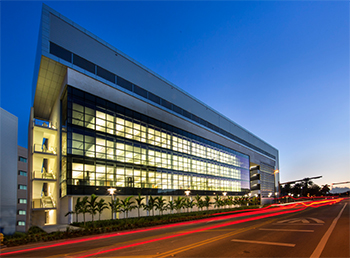Perkins+Will Earns Accolades for FIU Science Complex Design
 MIAMI — Opened in March 2013, the Florida International University (FIU) Science Classroom Complex has since received accolades for its sustainable design. The latest: It was one of two education projects designed by Miami-based Perkins+Will to be honored by the Florida Association of the American Institute of Architects at the 2014 AIA Florida Honor & Design Awards in July. The other was the University of Florida Clinical and Translational Research Building.
MIAMI — Opened in March 2013, the Florida International University (FIU) Science Classroom Complex has since received accolades for its sustainable design. The latest: It was one of two education projects designed by Miami-based Perkins+Will to be honored by the Florida Association of the American Institute of Architects at the 2014 AIA Florida Honor & Design Awards in July. The other was the University of Florida Clinical and Translational Research Building.
The 137,000-square-foot science classroom complex was conceived as the first phase of development of the Health Sciences district on the northeast corner of FIU’s main campus, said Pat Bosch, design director at Perkins+Will’s Miami office. It was developed to provide multidisciplinary research facilities to the Health Science district and to increase educational spaces for the School of Medicine as well as create more space for faculty offices, she added.
It will provide research and classroom space for multiple colleges — the Colleges of Arts & Sciences; Medicine, Engineering and Computing; Nursing and Health Sciences; and Public Health and Social Work — on campus. The design provides lab and research spaces, which are fully flexible for departments to expand and contract as needed to accommodate present and future research trends and needs.
“One key design element was the inclusion of flexible and adaptable wet labs as well as dry labs on each floor that would create communities of researchers within different colleges coming together,” Bosch said. “These collaborative spaces represent innovation and a culture of discovery, thus having a bundling represent how science meets art and creates a smart building utilizing high-performing strategies on all systems at its core and shell.”
One challenge that the design team faced during the process was figuring out how to create a self-shading building without adding cost and unnecessary elements, Bosch said, as well as creating an externally and internally transparent and visually connected building that would showcase research.
“Maintaining flexibility and adaptability was imperative to allow for FIU to grow their research program,” Bosch said. “Challenges were successfully dealt with by having a close partnership with our client. Their leadership and their clear directives instructed us to deliver a building that was based itself on research, energy modeling, daylighting mapping, facts and function rather that assumptions and subjectivity.”
Bosch added, “I learned that a successful design process complements the research process. Allowing for a disciplined analysis of all needs and criteria, and allowing the building to emerge as required, made for a smooth, satisfying design experience.”
The facility is currently tracking LEED Gold certification and was designed with the latest technologies available for 21st century learning and discovery— some of the key reasons it recently received the AIA award.
“The architecture represents the next generation of buildings not only at FIU but in this country’s higher education spectrum,” Bosch said. “It’s part of a subset of innovative buildings that respond to their context and their functions internally and externally.”
